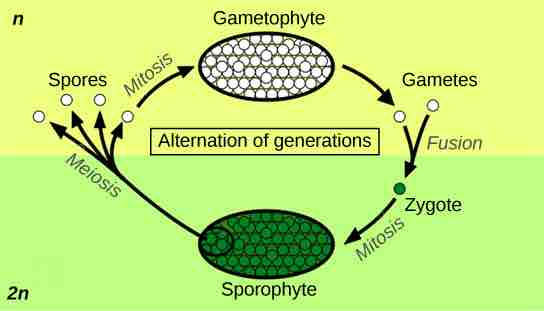Plant Adaptations to Life on Land
As organisms adapted to life on land, they had to contend with several challenges in the terrestrial environment. The cell's interior is mostly water: in this medium, small molecules dissolve and diffuse and the majority of the chemical reactions of metabolism take place. Desiccation, or drying out, is a constant danger for organisms exposed to air. Even when parts of a plant are close to a source of water, the aerial structures are prone to desiccation. Water also provides buoyancy to organisms. On land, plants need to develop structural support in a medium that does not give the same lift as water. The organism is also subject to bombardment by mutagenic radiation because air does not filter out the ultraviolet rays of sunlight. Additionally, the male gametes must reach the female gametes using new strategies because swimming is no longer possible. As such, both gametes and zygotes must be protected from desiccation. Successful land plants have developed strategies to face all of these challenges. Not all adaptations appeared at once; some species never moved very far from the aquatic environment, although others went on to conquer the driest environments on Earth.
Despite these survival challenges, life on land does offer several advantages. First, sunlight is abundant. Water acts as a filter, altering the spectral quality of light absorbed by the photosynthetic pigment chlorophyll. Second, carbon dioxide is more readily available in air than water since it diffuses faster in air. Third, land plants evolved before land animals; therefore, until dry land was also colonized by animals, no predators threatened plant life. This situation changed as animals emerged from the water and fed on the abundant sources of nutrients in the established flora. In turn, plants developed strategies to deter predation: from spines and thorns to toxic chemicals.
Early land plants, like the early land animals, did not live far from an abundant source of water and developed survival strategies to combat dryness. One of these strategies is called desiccation tolerance. Many mosses can dry out to a brown and brittle mat, but as soon as rain or a flood makes water available, mosses will absorb it and are restored to their healthy green appearance. Another strategy is to colonize environments where droughts are uncommon. Ferns, which are considered an early lineage of plants, thrive in damp and cool places such as the understory of temperate forests. Later, plants moved away from moist or aquatic environments and developed resistance to desiccation, rather than tolerance. These plants, like cacti, minimize the loss of water to such an extent they can survive in extremely dry environments.
The most successful adaptation solution was the development of new structures that gave plants the advantage when colonizing new and dry environments. Four major adaptations are found in all terrestrial plants: the alternation of generations, a sporangium in which the spores are formed, a gametangium that produces haploid cells, and apical meristem tissue in roots and shoots. The evolution of a waxy cuticle and a cell wall with lignin also contributed to the success of land plants. These adaptations are noticeably lacking in the closely-related green algae, which gives reason for the debate over their placement in the plant kingdom.
Alternation of Generations
Alternation of generations describes a life cycle in which an organism has both haploid and diploid multicellular stages (n represents the number of copies of chromosomes) . Haplontic refers to a lifecycle in which there is a dominant haploid stage (1n), while diplontic refers to a lifecycle in which the diploid (2n) is the dominant life stage. Humans are diplontic. Most plants exhibit alternation of generations, which is described as haplodiplodontic. The haploid multicellular form, known as a gametophyte, is followed in the development sequence by a multicellular diploid organism: the sporophyte. The gametophyte gives rise to the gametes (reproductive cells) by mitosis. This can be the most obvious phase of the life cycle of the plant, as in the mosses. In fact, the sporophyte stage is barely noticeable in lower plants (the collective term for the plant groups of mosses, liverworts, and lichens). Alternatively, the gametophyte stage can occur in a microscopic structure, such as a pollen grain, in the higher plants (a common collective term for the vascular plants). Towering trees are the diplontic phase in the life cycles of plants such as sequoias and pines.

Alternation of generations of plants
Plants exhibit an alternation of generations between a 1n gametophyte and 2n sporophyte.
Protection of the embryo is a major requirement for land plants. The vulnerable embryo must be sheltered from desiccation and other environmental hazards. In both seedless and seed plants, the female gametophyte provides protection and nutrients to the embryo as it develops into the new generation of sporophyte. This distinguishing feature of land plants gave the group its alternate name of embryophytes.